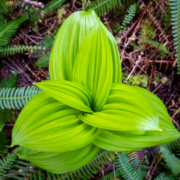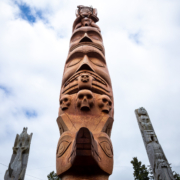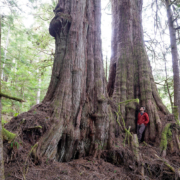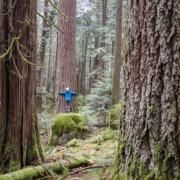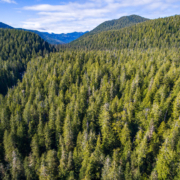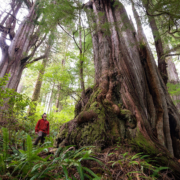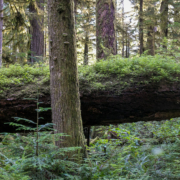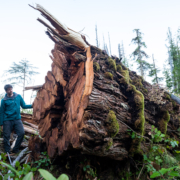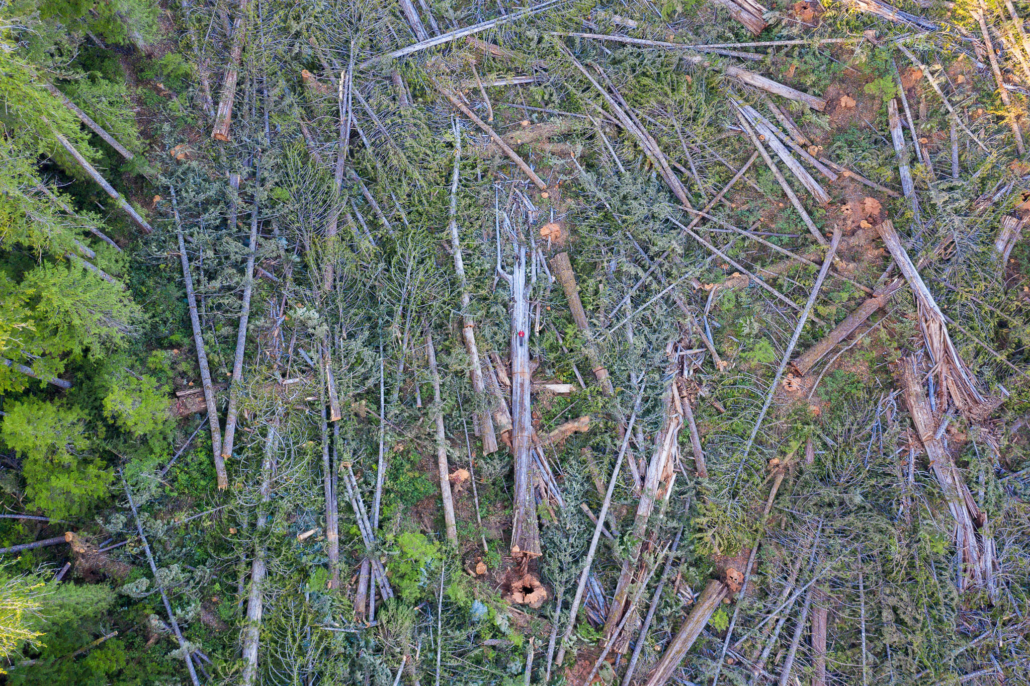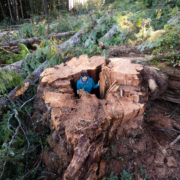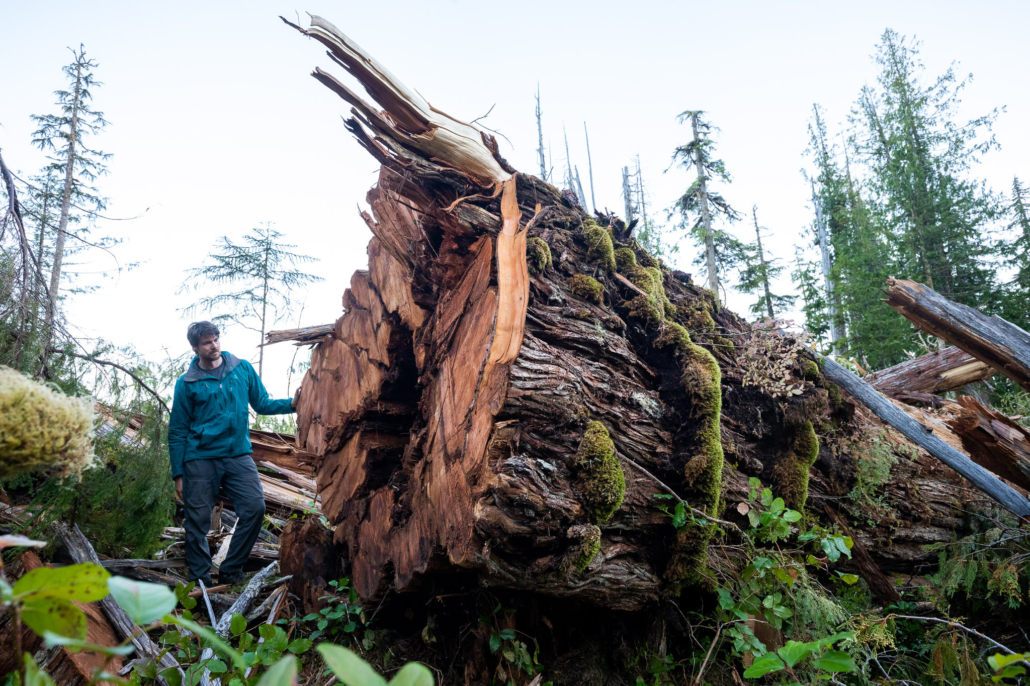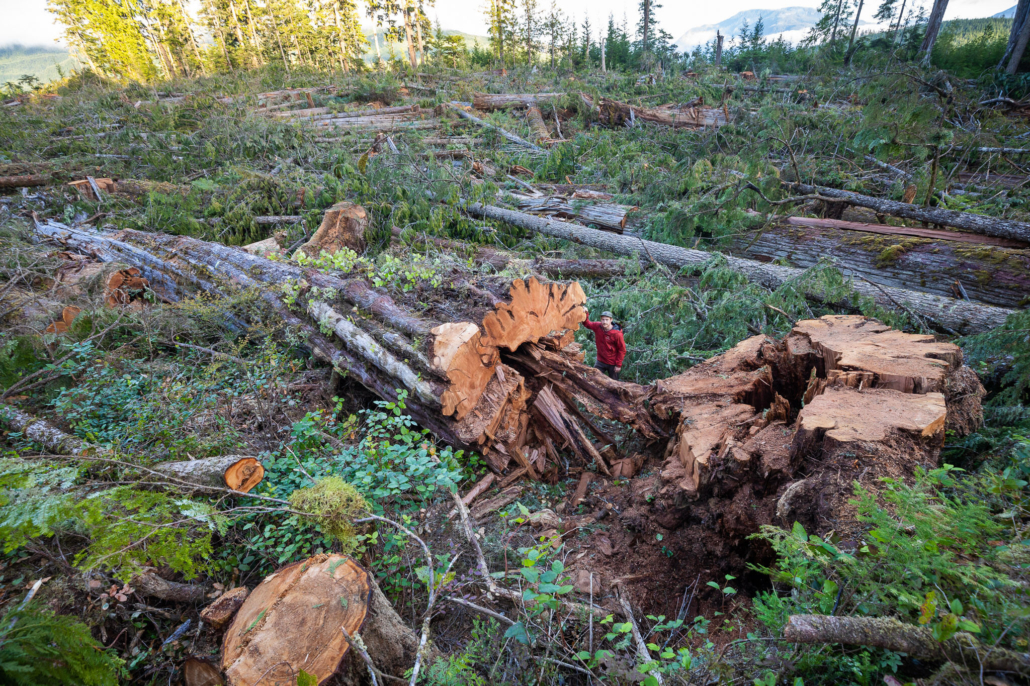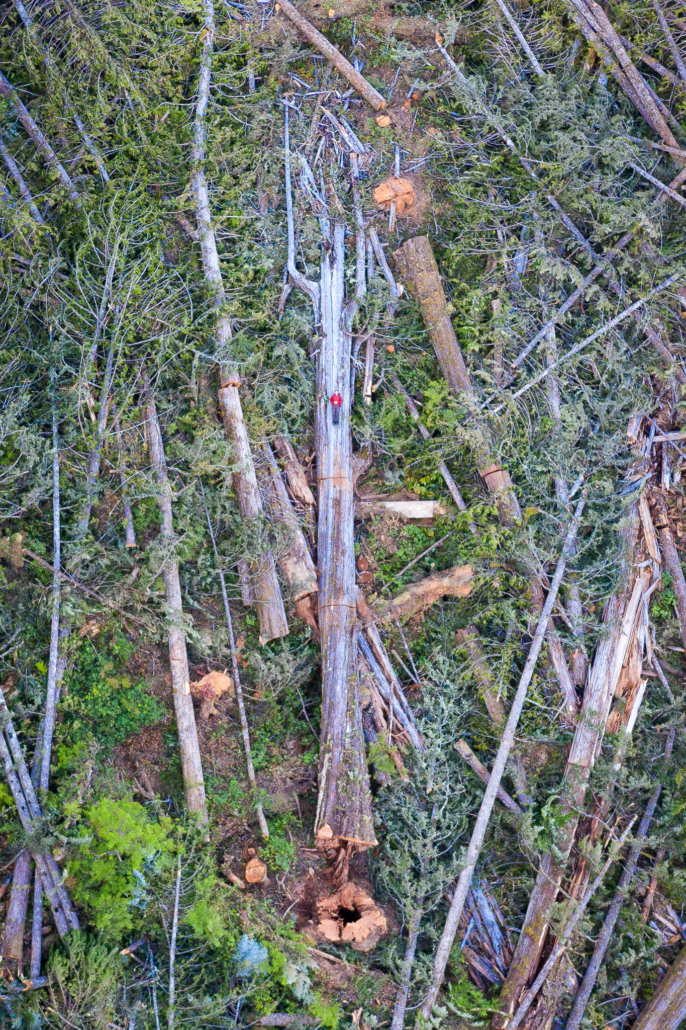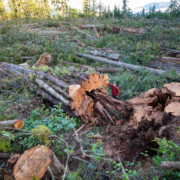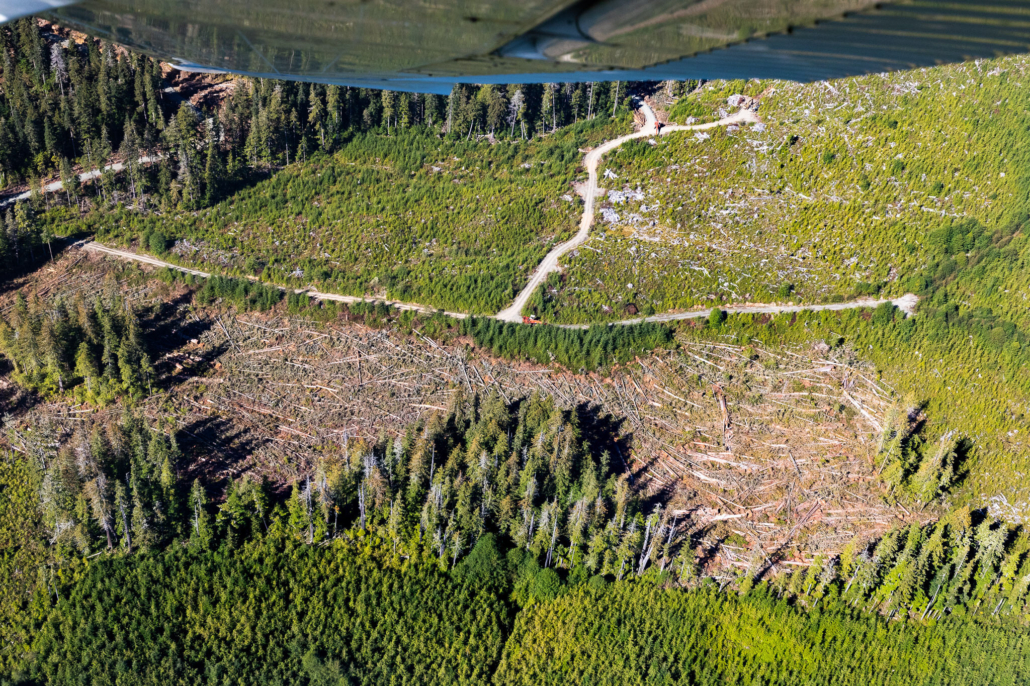May 26, 2023
Canadian Geographic
By Madigan Cotterill
How a niche British Columbia-based community is working to bring attention to the importance of old-growth forests
Amanda Lewis stands completely alone on the edge of British Columbia’s Stewart-Cassiar Highway, contemplating her next step as she confronts a wall of dense, dark trees. Will she venture into the woods unaccompanied, potentially risking her life to reach her destination? Or will she decide to wait for the company of others, knowing there is safety in numbers?
It’s a cloudy summer day, and Lewis is searching for one of Canada’s largest trees, a subalpine fir initially located in 1987. It is already late in the day, and it would take Lewis at least 30 minutes of trekking through the bush to reach the tree. An occasional car passes her on the highway — the only sign of human life as she debates her next move.
If she runs into trouble deep in the forest, Lewis knows that finding her would be difficult as no marked path leads to her destination. “Am I overthinking,” she asks herself. “Should I just zip in and get to this tree?”
She texts her sister, an archeologist with experience in the forest, who points out the danger of going in alone. She makes the tough decision to wait until she is in the company of others before embarking on her quest.
Lewis, who has been a big-tree hunter since 2018, has been on a mission to visit each of the 43 champion trees in the BC Big Tree registry and chronicle that journey through her memoir, Tracking Giants. Like many big-tree hunters, Lewis’ passion for the environment continues to bring her back to the forest where ancient trees have stood for hundreds, sometimes even thousands, of years. But as each day passes, more ancient trees in BC disappear, felled by logging.
Old-growth forests have significant ecological value and play a key role in climate resilience and biodiversity. They are home to many animals, including grizzly bears, black bears, coastal wolves and black-tailed deer, which all rely on these ancient forests for survival. Old-growth forests contain about 90 per cent more shrubs and forbs than second-growth environments, resulting in a complex heterogeneous canopy with light pouring into the understudy. Great reservoirs of biodiversity, old-growth forests also boast an unparalleled ability to keep carbon out of the atmosphere. Yet, with each passing day, these ancient ecosystems continue to vanish, felled by intense logging.
An interactive map released by Conservation North, a science-based conservation organization, shows how much of BC’s last primary forests have been disturbed. A sea of red makes it obvious just how much of the province’s forests have been disturbed. According to the province, BC has about 11.1 million hectares of old-growth forest, 10 million of which are protected or not economical to harvest. However, despite the government’s promise to maintain these forests, logging continues apace, with companies such as Drax Global, the UK’s largest renewable energy company, moving in, wiping large expanses of primary forest.
Conservation photographer and big-tree hunter TJ Watt has been using his camera to document the disappearance of ancient trees in a powerful Before & After series. Watt hopes to draw viewers’ attention to their destruction by highlighting the incredible grandeur of old-growth ecosystems. A Trebek Initiative grantee, Watt often photographs himself beside a tree, using his body to provide a perspective on just how magnificent these ancient giants are. He reshoots the same image after the tree has been logged, a massive stump is all that remains.
“I’m trying to remind people that unless we speak up and advocate for the permanent protection of endangered old-growth forests, which will happen through conservation financing for First Nations to support sustainable economic development in those communities while also offsetting lost logging revenues when old-growth is deferred and protected, then we will continue losing ancient ecosystems that are second in grandeur only to the redwoods of California,” says Watt. “These trees take many centuries or even 1,000 years to grow, and nobody’s waiting around for them to come back again.”
Deep in the forest, there is no cell reception, designated trail or signage indicating you are on the right path. In the middle of the woods, everything is up to instinct and the natural inclination that something larger than life is just around the corner. When it comes to big-tree tracking, hunters have an inherent desire to be in the presence of something giant.
They feel an emotional connection to each ancient tree. For them, being with such a tree is akin to visiting a relic like Stonehenge or the Parthenon. This spiritual relationship often drives hunters to risk their lives to locate these giants in some of the last untouched* areas of the planet.
It’s late June 2022 in Lynn Headwaters Regional Park, BC, and two friends are about to make the discovery of a lifetime. Both experienced outdoorsmen, Ian Thomas and Colin Spratt have been big-tree hunters for about three years. “Nature is where I feel at peace,” says Spratt. “It’s my therapy.”
On this midsummer day, they hike into the Lynn Valley under a blanket of fog. Moving at a snail’s pace, the two tree-hunters clamber over logs and under branches, driven by the thought of “What if?”
After about 10 hours of bushwhacking, they find it — the North Shore Giant.
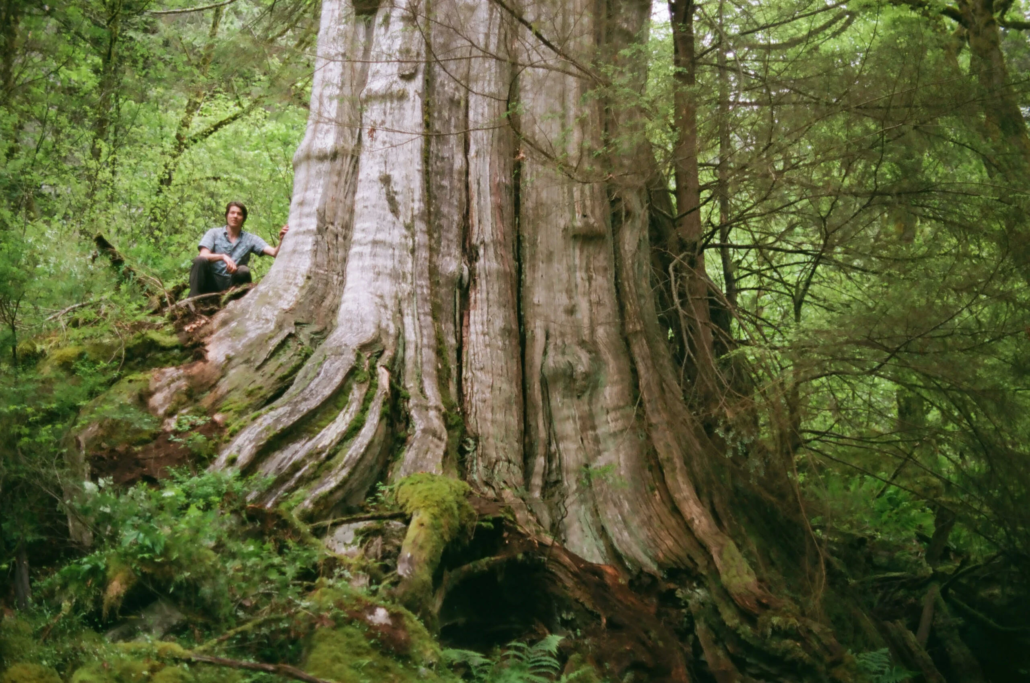
Ian Thomas beside the North Shore Giant. (Photo: Colin Spratt)
“Oh my god, this is the biggest tree I have ever found!” says Thomas. Spratt is frozen, unable to believe his eyes as he watches Thomas approach the tree, seeming to shrink as his body is dwarfed by the enormous tree. Named by Spratt and Thomas, the North Shore Giant is thought to be about 2,000 years old and is estimated at 5.8 metres in diameter, making it Canada’s fourth-widest tree. For Spratt, big-tree hunting is not just a Guinness Book of World Records pursuit; it is a way to experience the last untouched areas of the planet while making the point that if these areas are not protected, thousands of years of biodiversity, ecology and significant ecosystems will be lost.
Hundreds of massive logs continue to be hauled out of BC’s forests. A 2019 report from the Sierra Club of BC found that 3.6 million hectares of forest was clear-cut between 2005 and 2017, a combined area larger than Vancouver Island. Once cut, these areas become “sequestration dead zones” that release more carbon than they absorb.
A forest technologist with British Columbia Timber Sales, Greg Herringer is a knowledgeable big-tree hunter who helps to manage a legacy big-tree program that reserves large trees in the area he supervises. Herringer’s job requires him to target the best places for harvesting. “I walk a tightrope,” he says. “I am conflicted most of the time between satisfying the needs of what British Columbia Timber Sales is mandated to do and my ethics and moral values.”
Herringer explains that his supervisors view him as a “pain in the ass” because his job is to advocate for reserving trees in certain areas. He often explores with fellow big-tree hunters, as well as experienced outdoors people like Mick Bailey.
For more than 40 years, Bailey has searched the forests for big trees and documented his experiences on his blog, BCtreehunter. He wants more people to be aware of the consequences of cutting down these giants. As a mentor to younger big-tree hunters, he hopes their use of social-media platforms like Instagram will allow them to connect with like-minded individuals and reach a wider audience of concerned people. He often gets together with other tree hunters to venture into the woods. “We call ourselves the ‘tree crew,’” says Lewis. “I enjoy tree tracking a lot more now. Going out with a group is way more fun.”
By going in and ground truthing areas of BC far from the public eye, big-tree hunters show communities what is still standing and what needs to be saved. “By getting out in the forest, by being the sort of boots on the ground, finding these incredibly rare ancient trees, we’re able to effectively advocate for their protection,” says Thomas.
“It’s up to us to ensure these trees are protected, and I encourage people to safely get out there and explore the landscapes themselves,” says Watt. “Reconnect with nature and see what you might find.”
*Although old-growth forests may have been “untouched” by logging, they were used by First Nations peoples for millennia and often still bear the markings of cultural use, be that bark stripping on trees, test holes, or even old canoes in the forest.
See the original article with more photos here.

